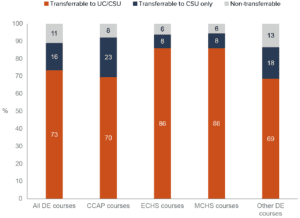Transfer students from various California community colleges are excited to join the masses at different University of California (UC) schools this upcoming Fall term. How did they get there? Why have I been stuck at the same CC for two years with no end in sight?
Community college can be a great way to start your path to a four-year degree. Still, if you’re hoping to eventually transfer to one of the University of California’s (UC’s) nine undergraduate campuses, there are a few things you need to know.
UC Transfer Students’ Data
The UC system is one of two public university systems in California. UC institutions educate over 200,000 students and operate ten campuses. The UC provides bachelor’s, master’s, doctoral, and professional degrees as well as opportunities for post-degree continuing education.
What percent of UC students are transfers?
Transfer students are quite common on UC campuses. Nearly 30 percent of all UC undergraduates are transfer students, 1 in every 3 students at UC.
More importantly, 92 percent of transfers come from a California community college. The UC system is committed to helping California students. It recognizes that the transfer community is vital to the fabric of the UC student community.
Admission of California Community College transfer students grew slightly to 26,700 students from 26,582 in fall 2018, keeping with UC’s goal of enrolling one new California transfer student for every two new California freshmen.
Do California Community college students receive priority?
Yes! California CC students, who have completed the required minimum requirements, are given priority consideration in enrollment.
The UC system is committed to increasing access and opportunity for CCC transfer students. The goal is to enroll one new California transfer student for every two new California freshmen.
The university’s transfer enrollment is expected to rise in the coming years from a growing awareness of transfer campaigns such as the UC Transfer Pathways program and the Transfer Admission Guarantee (TAG) program.
These programs provide a roadmap of course preparation for the university’s most sought-after majors.
How much do UC graduates make on average?
Graduates of the University of California earn competitive salaries relative to other Californians and have a long-term earning potential that increases.
According to one report, graduates earn approximately $40,000 after two years, $81,000 after eleven years, and $104,000 after seventeen years of employment.
Transfer to UC Path
A lot of students entering community college have the goal of eventually transferring to a UC campus. Transferring can be fairly straightforward for students who are focused and have their sights set on a specific school and major.
However, many students enter community college without knowing what they want to study or where they want to transfer to.

In these cases, it’s essential to take some time to explore your options and figure out what you’re interested in. If you’re unsure where you want to go or what to study, taking some time to explore your options can help you choose the right path.
Admission Requirements
To be eligible for UC admission, students must fulfill both of the following requirements:
Students must earn 60 semester (90 quarter) units of transferable college credit with a GPA of at least 2.4 (2.8 for non-residents). 14 semesters or 21 quarter courses may not be taken Pass/Not Pass.
Students must also complete coursework in the following subject areas:
- English composition (2)
- Mathematical concepts and quantitative reasoning (1)
- Arts and humanities/social and behavioral sciences/physical and biological sciences (4 in 2 different subject areas)
Each course must be valued at least three-semester units (4.5 quarter units). Remember that while some academic criteria are uniform across campuses, others may differ based on your majors. To ensure that every course you take is transferable to the UC system, use ASSIST.
Look through UC’s major preparation pathways for assistance in deciding which classes to complete based on your majors. There are a few things that students should keep in mind when planning their coursework, especially if they’re hoping to transfer to a UC campus.
Course Selection and Major Preparation
First and foremost, priority should be placed on trying to complete every major preparation course. For some majors, these are required in order for students to even be considered as transfer applicants.
Additionally, when universities receive more applications than they have spots for, they typically select the students who appear to be the most prepared for the major they’ve applied to.
So, not only is major preparation coursework necessary to be eligible to transfer, but it’s also crucial in increasing the likelihood of being admitted to the institution of your choice.
Math requirements are often a point of issue for many students because every UC campus can differ on what they need finished depending on the major preparation and choice.
General Education Coursework
In addition to major preparation courses, students should also try and complete nearly all of the General Education requirements. GE is not required for admission to a university; however, it is required for graduation once students have transferred.
Thus, while GE may not be necessary during the application process, it’s still something that needs to be completed down the line.
By being mindful of both major preparation courses and General Education requirements, students can set themselves up for success in transferring and graduating from a university.
Transfer Admission Guarantee (TAG program)
The Transfer Admission Guarantee (TAG) program can be an excellent resource for CCC looking to transfer to a UC school. TAG provides an admissions guarantee to eligible students who meet specific requirements.
It is offered at most UC campuses. Students attending a CCC and fulfilling specific criteria can guarantee admission through the TAG program.
Students obtain early access to their academic records, admissions notifications, and specialized academic guidance based on their majors. Students must complete a TAG application and submit it to their college counselor or TAG advisor for evaluation if they want this assurance.
Refer to the TAG Matrix to see if the UC campus you are looking at offers the TAG program. Ensure you understand the application filing periods to be guaranteed admission to most UCs.
Transfer Pathways
If you’ve already decided on your major but want to keep your campus options open, a UC Transfer Pathway could be the route for you. UC’s Transfer Pathways Guide can help you find out which community college courses you need to complete for a specific Transfer Pathway.
The Transfer Pathways programs can help those who want to make themselves competitive across the UC system and prepare for a seamless transfer process.
Some majors listed may want fewer courses for admission, but none will expect more. It’s a smart move to apply to multiple schools to improve your chances of getting in.
Students from historically underrepresented groups comprise 37 percent of admitted transfer students. Chicano/Latino students and white students comprised the largest ethnic groups at 31 percent, respectively, followed by Asian Americans at 28 percent.
African Americans represented 5 percent of admitted transfers, while American Indians and Pacific Islanders made up nearly 1 percent of admitted transfer students.
UC Transferable Courses
One of the best tools for transfer students is Assist.org. The website displays a series of articulation agreements between every UC campus and the plethora of California community colleges.
Make sure you accomplish a competitive grade point average (GPA) to meet the requirements to obtain junior-level transfer status.
UC Application
Starting the application for campus can be a bit daunting; the first thing you’ll need to do is create an account. Using a non-school-issued email account (e.g., Gmail, Yahoo) is also a good idea.
Campuses send important, time-sensitive correspondence to applicants, so you should check your email regularly (including your spam folders).
Create an Account
After you create an account, you’ll need to select the term you’re applying for (when you hope to start at UC) and your applicant level (e.g., freshman, transfer, etc.).
You’re considered a transfer applicant if you’ve graduated high school and are enrolled in a regular session (fall, winter, or spring) at a college or university.
Application Fees
The application fee for each UC campus is $70 ($80 for non-immigrant or international students).
Please be mindful of the UC campuses you are applying to because once the application is submitted, you are required to pay for all of the campus choices you made (even if you cancel the application later).
Contact Us if you have any questions about how to transfer to UC. Donate today if you feel like supporting our mission.





